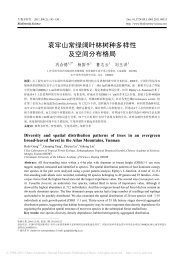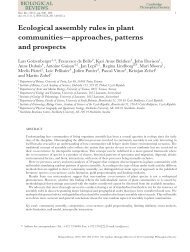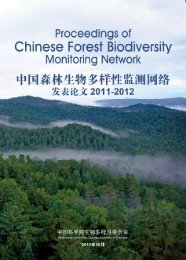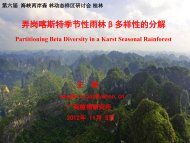the maintenance of species-richness in plant communities
the maintenance of species-richness in plant communities
the maintenance of species-richness in plant communities
You also want an ePaper? Increase the reach of your titles
YUMPU automatically turns print PDFs into web optimized ePapers that Google loves.
Ma<strong>in</strong>twnce <strong>of</strong> <strong>species</strong>-<strong>richness</strong> <strong>in</strong> <strong>plant</strong> <strong>communities</strong> 115<br />
Table I. The results <strong>of</strong> two experiments <strong>in</strong> which all possible pairs <strong>of</strong> <strong>species</strong> with<strong>in</strong><br />
certa<strong>in</strong> groups <strong>of</strong> <strong>species</strong> were grown toge<strong>the</strong>r and a rank order establkhed<br />
Species<br />
affected<br />
(a) From Bomkamm (1961 a)<br />
Decreas<strong>in</strong>gly strong<br />
competitors<br />
S S A>VaT<br />
A S A TaV<br />
V S ABV T<br />
T S A V T<br />
S = Simpis alba, A = Avena sativa, V = Vicia sativa, T = Triticum aestivum.<br />
Species affected<br />
L<br />
A<br />
D<br />
P<br />
F<br />
M<br />
X<br />
C<br />
H<br />
(b) From Caputa (1948) - results <strong>of</strong> 1944<br />
Species decreas<strong>in</strong>gly aggressive to test <strong>species</strong><br />
M L H X F P C A D<br />
L M A X F P C H D<br />
L M=X A=F D P C H<br />
L D F A X M P H C<br />
L M=A P X F C H D<br />
L X M C H A P D F<br />
L D A X P F M = C H<br />
L M X A D F H P C<br />
L M X A D P F H C<br />
strongly aggressive (<strong>in</strong> top two places for 719 <strong>species</strong>) :<br />
L = Lolium italicurn<br />
M = Medicago sativa<br />
Moderately aggressive (<strong>in</strong> third, fourth or fifth places for 7/9 <strong>species</strong>):<br />
A = Arrhena<strong>the</strong>rum elatius<br />
X = Trifolium pratense<br />
Slightly aggressive (<strong>in</strong> fifth, sixth or seventh places for 719 <strong>species</strong>):<br />
F = Festucapratensis<br />
P = Phleumpratense<br />
Not aggressive (<strong>in</strong> seventh, eighth or n<strong>in</strong>th places for 719 <strong>species</strong>) :<br />
C = Lotus corniculatus<br />
H = T7Z~ObII hybridurn<br />
Very variable (from second to n<strong>in</strong>th place) :<br />
D = Dactyl& glomerata<br />
<strong>species</strong> only succeeded if it <strong>in</strong>vaded <strong>the</strong> pioneer or degenerate phase <strong>of</strong> <strong>the</strong> o<strong>the</strong>r. Such<br />
a relationship provides a possible basis for <strong>the</strong> <strong>in</strong>def<strong>in</strong>ite persistence <strong>of</strong> two such<br />
<strong>species</strong> <strong>in</strong> mixture.<br />
These various approaches to <strong>the</strong> analysis <strong>of</strong> <strong>plant</strong> <strong>communities</strong> that do not <strong>in</strong>volve<br />
a consideration <strong>of</strong> regeneration - or only a m<strong>in</strong>imal study <strong>of</strong> it - provide several<br />
dist<strong>in</strong>ct ways <strong>of</strong> expla<strong>in</strong><strong>in</strong>g long-term co-existence <strong>of</strong> some <strong>plant</strong> <strong>species</strong>, but <strong>the</strong>y do<br />
not conv<strong>in</strong>c<strong>in</strong>gly ‘expla<strong>in</strong>’ <strong>the</strong> long-term co-existence <strong>of</strong> <strong>the</strong> numerous <strong>species</strong> with<br />
essentially <strong>the</strong> same life-form, adult phenology and habitat-range, that are characteristic<br />
<strong>of</strong> so many <strong>species</strong>-rich <strong>communities</strong>.
















